Above photo: Striped flea beetles on a canola plant
(Photo Courtesy of Agriculture-Agrifood Canada)
Scout a couple of times in the first few weeks after emergence, and look for:
1. Seeding issues. Check that the seeding job measured up to expectations, and if seeding equipment met the need. Look for emergence patterns that may indicate an issue with depth control, leveling, compaction, packing or speed that can be adjusted for next year. Crusting could also be a factor. If you tested a few strips without seed-placed fertilizer, for example, see if that small area looks better or worse than the neighboring pass.
2. Plant Stand. Record the plants per square foot at various locations to see how well canola established based on the combination of variety, seeding rate, thousand-seed weight, equipment and moisture. Keep this information along with seeding rate, rainfall before and after seeding, soil temperature at seeding, and general soil conditions (lumpy, mellow, etc.). This data will help establish and understand the seedling survival rate for that field this year. Top 10 details to record at seeding time.
3. Frost damage. When canola fields get an early season frost, wait at least 4 days after the frost even to assess regrowth before making a reseeding decision. Click here for more frost assessment tips.
4. Weeds present and staging. Early in-crop spray applications get weeds when they’re small and easier to control, and before they can take moisture and nutrients away from the crop. Check what weeds are present. For example, if grassy weeds are present in Liberty Link canola, two applications of Liberty or a graminicide tank mix with Liberty may be required.
5. Weed escapes. Any weeds that should have been controlled with a spray but weren’t could be resistant. One weed to watch for is kochia. It takes 14-21 days after a pre-seed glyphosate application for glyphosate-resistant weeds to become obvious. Any kochia growing where all other kochia have been controlled or large patches of kochia that lived through a pre-seed burnoff could mean resistance. Time for a suspicious-weed take down.
6. Flea beetles. Canola is at greatest risk up to the 4-leaf stage, although in some cases they can feed all season long. If flea beetles are overwhelming the seed treatment, then consider a spray if more than 25% of cotyledon area has been eaten and flea beetles are still actively feeding on the crop. Examine newer leaves for recent damage. Note that feeding may be on the underside of the cotyledons in cooler conditions. Canola seed treatments require a bit of feeding to stop flea beetles, so older leaves may show some damage for this reason while newer leaves may be undamaged. Watch for at least two species of flea beetles in most fields. Striped flea beetles emerge before crucifer flea beetles and some seed treatments may not work as well on striped flea beetles.
7. Cutworms. Look for bare patches and dig around the perimeter of the patch to look for cutworms just below the soil surface. A number of insecticide options exist for cutworm control. However, if scouting determines that wireworms or gophers are the problem, the sprayer does not provide a solution. The preferred time to spray for cutworms is in the evening or at night. Click here for more on cutworm identification, scouting and management.
8. Seedling diseases. Often if seed and seedlings are damaged by rots and blights, which tend to be a more common occurrence in cool soils, they will quickly dry up and disappear. Accurate diagnosis requires frequent scouting. In patches of missing plants, look for wilting or dead seedlings. Examine the roots and hypocotyls for signs of decay, and dig in the seed row to find the seeds. If ungerminated seeds are still firm and intact, it may have been too dry for them to sprout. But if the soil is moist and the seeds are squishy and rotten, they are diseased and unlikely to grow.
?
9. Herbicide carryover damage. Dry conditions last season can increase the risk situation for herbicide carryover into this spring. Applying residual products late in the season, at higher rates or repeatedly over time can increase the carryover risk. Soils with higher organic matter are at reduced risk of herbicide carryover because they tend to have more microbial activity and more moisture for breakdown as well as more binding sites to capture some of the excess residue. Soil pH is also a factor, depending on the herbicide: certain Group 2 sulfonylureas breakdown slower in high pH (alkali) soils and Group 2 IMIs break down slower in low pH (acidic) soils.
10. Environmental damage. Have plants succumbed to wind, hail, dry conditions, or excess moisture?
If any of these Top 10 are present and viability of the stand is in question, read this article on reseeding.






